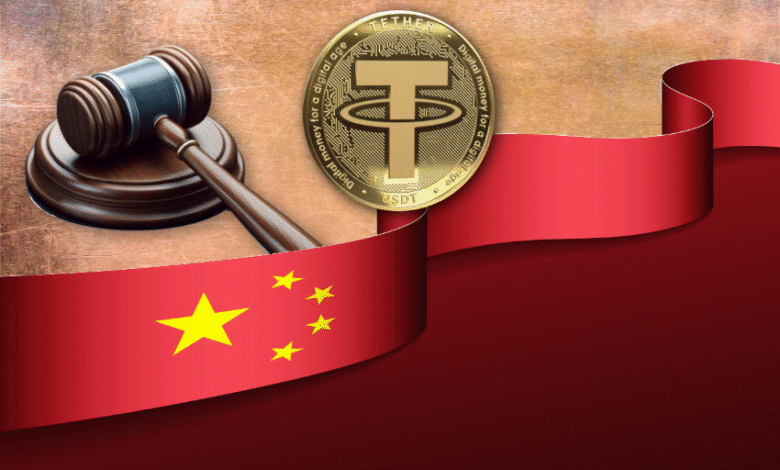China Stablecoin Crackdown: Shifting Regulatory Landscape

The recent China stablecoin crackdown marks a significant shift in the country’s approach to digital currencies, highlighting the tensions between regulation and innovation in financial markets. As authorities swiftly directed local brokers and think tanks to cease promoting stablecoins, the move underscores heightened anxieties over fraud and speculative trading. Despite China’s overarching cryptocurrency policy, regulators have previously hinted at exploring stablecoin models to enhance cross-border payments and manage capital flow. With the introduction of the digital yuan and the rise of Hong Kong’s crypto licensing framework, the recent clampdown has raised questions about the future of cryptocurrency regulation in China. Investors and analysts alike are keeping a close eye on stablecoin news, as this crackdown could reshape the landscape of China’s financial markets for years to come.
The recent developments surrounding China’s stance on digital currencies have sparked significant discourse within the financial community. The unexpected decision to impose restrictions on local stablecoin promotion illustrates the precarious balance regulators must strike with innovation. As the country experiments with its digital yuan, the implications for broader cryptocurrency regulation become increasingly complex. The crackdown signifies a multifaceted response to concerns over both capital outflows and speculative behavior in a rapidly evolving landscape. As various stakeholders analyze the shifting regulatory environment, deeper insights into China’s financial future emerge, revealing the intricate dynamics at play.
China’s Stablecoin Regulation: A Sudden Shift
In a surprising turn of events, China’s regulatory landscape for stablecoins has shifted dramatically. Initially, the Chinese government had taken a cautious approach, cautiously exploring the potential of stablecoins to facilitate efficient cross-border transactions and curb capital outflows. However, recent instructions from Beijing have signaled a hardline stance against promoting these digital assets. In particular, local brokers and financial think tanks have been ordered to cease their research and outreach efforts surrounding stablecoins, reflecting a swift pivot in the country’s cryptocurrency policy.
This crackdown is not merely a response to concerns about fraud and speculation. The move is also prompted by a significant rise in over-the-counter crypto transactions, which reached approximately $75 billion in early 2024. With the ongoing introduction of the digital yuan, there is a pressing need for China to maintain control over its financial markets and mitigate risks linked to decentralized cryptocurrencies. The juxtaposition of the exploration of stablecoin technologies with this crackdown highlights the delicate balancing act Chinese regulators face amid a rapidly evolving digital finance ecosystem.
Impact of the Digital Yuan on China’s Cryptocurrency Policy
The digital yuan, or e-CNY, is at the forefront of China’s efforts to modernize its financial system and enhance its global economic standing. The increasing focus on the digital yuan is both an opportunity and a threat to the existing landscape of cryptocurrencies and stablecoins. While the central bank digital currency aims to provide a secure and regulated alternative, the rapid diversification in the cryptocurrency market poses challenges for traditional financial systems. The prohibition of stablecoins could be seen as an effort to safeguard the digital yuan’s position as a dominant currency in both local and international markets.
With the digital yuan, the government envisions enhanced transaction speeds and reduced costs for cross-border payments. However, the concerns regarding capital flight and speculative trading remain prevalent. As such, the cryptocurrency policy may evolve to incorporate regulations that reinforce the digital yuan’s role while still exploring the potential efficiencies that new stablecoin models might offer. This reflects a nuanced understanding of how digital assets can contribute to the broader financial goals of the country.
Stablecoin News: Insights from Global Markets
The global market for stablecoins has attracted significant attention, especially in light of varying regulatory responses from different countries. As nations navigate their own paths regarding stablecoin adoption and cryptocurrency regulations, China’s recent moves serve as a cautionary tale for regulators worldwide. Observing Beijing’s abrupt shift can provide insights into the delicate equilibrium between innovation and regulation that many governments strive to achieve.
Simultaneously, the introduction of a regulated stablecoin framework in Hong Kong has raised eyebrows. This contrast highlights how international responses to stablecoins can diverge, creating potential competitive advantages for jurisdictions that support such innovations. China’s stringent regulations could inadvertently drive enthusiasts and businesses to seek more favorable environments for their cryptocurrency operations, thereby affecting the broader financial ecosystem.
Future Directions for China’s Financial Markets
The evolution of China’s financial markets in light of recent stablecoin developments points to a possible reconciliation between stringent regulation and technological innovation. As regulators assess the effectiveness of current policies, there may be room for re-evaluating the potential benefits of stablecoin integration, especially with lessons learned from international counterparts. Policymakers will need to strike a balance that mitigates risks while fostering growth in digital finance, especially as global interest in stablecoin applications rises.
In the longer term, this may involve revisiting the design of potential stablecoin offerings that align with the digital yuan’s objectives. The challenge lies in ensuring that such innovations don’t undermine the specificity of China’s financial directives. Developing a state-backed stablecoin could indeed enhance China’s leverage in international finance, providing a counterbalance to the dominance of US dollar-based transactions within global trade. Ultimately, the direction of China’s financial markets hinges on how well it navigates these dual demands of regulation and innovation.
Potential for State-Backed Stablecoins
As discussions surrounding state-backed stablecoins gain momentum, it’s vital to consider their implications within the broader context of China’s financial strategy. A stablecoin tethered to the digital yuan could serve not only as a technological advancement but also as a tool to enhance China’s control over its monetary system. Moreover, this could fulfill economic goals such as facilitating international trade while minimizing risks associated with decentralized cryptocurrencies.
However, the potential for a state-backed stablecoin comes with its own set of regulatory challenges. It would require a framework that addresses concerns about consumer protection and market stability. As China grapples with these issues, it has the opportunity to set comprehensive guidelines that distinguish between innovative financial products and speculative assets, thereby ensuring a safer environment for investors and consumers alike.
The Role of Financial Authorities in Digital Assets
Financial authorities in China are now tasked with a critical responsibility as the landscape of digital assets evolves. Their actions will not only shape the future of stablecoins but also influence the trajectory of the digital yuan. The recent crackdown on stablecoin promotions underscores how seriously regulators view the potential risks of unregulated cryptocurrency markets. Authorities must establish clear guidelines that mitigate these risks while allowing for innovation to flourish in a controlled manner.
As we move forward, the adaptability of Chinese financial regulators will be tested against the backdrop of rapid technological advancements in the global crypto space. Authorities must remain vigilant and proactive, leveraging their knowledge of both domestic and international financial systems to ensure that they can effectively shape policies that foster responsible growth in digital assets. The convergence of cryptocurrency and stablecoin development with regulatory oversight presents both opportunities and challenges for the future grid of China’s financial markets.
Cross-Border Payments and Stablecoins
The ideal integration of stablecoins within China’s financial infrastructure could transform cross-border payments. By aligning a potential stablecoin with the digital yuan, the government could reduce transaction times and costs associated with international remittances. This would not only enhance the efficiency of cross-border trade but could also position China as a leader in the digital currency space.
However, facilitating these advancements requires careful regulation. Policymakers must address the risks tied to capital flight and ensures consumer security. This creates a complex puzzle for regulators to solve, balancing the desire for economic growth through technological adoption while safeguarding against potential financial instability caused by rapid shifts in digital asset ownership and use.
Global Implications of China’s Stablecoin Crackdown
China’s strict measures against stablecoins may have far-reaching implications beyond its borders. As one of the world’s largest economies, China’s stance on digital currencies influences market sentiment and regulatory approaches in other nations. The abrupt crackdown could lead to hesitance amongst other governments considering embracing digital currencies due to fears of similar volatility.
Conversely, this shift could inspire countries to pursue robust frameworks that protect against fraud while promoting legitimate innovation in the crypto space. The global reactions to China’s stablecoin policy will likely shape the future regulatory environment, potentially leading to new partnerships and agreements on digital currencies as nations strive to create a stable and secure economic landscape.
Technological Innovations and Regulatory Futures
As the landscape of digital currencies continues to evolve rapidly, technological advancements are pivotal in shaping future regulatory frameworks. Innovations in blockchain technology and smart contracts offer potential solutions for creating transparent and secure stablecoin ecosystems. This necessitates an adaptive regulatory environment that can keep pace with fast-moving developments while ensuring market integrity and consumer protection.
By leveraging technological innovations, regulators in China and elsewhere can devise strategies to promote responsible stablecoin use while concurrently mitigating risks associated with volatility and fraud. The outcome of such regulatory endeavors will ultimately determine how well the global economy can integrate digital assets into existing financial systems, paving the way for a more inclusive and comprehensive financial future.
Frequently Asked Questions
What is the significance of the China stablecoin crackdown?
The China stablecoin crackdown is significant as it marks a decisive shift in the country’s approach to stablecoins, signaling regulatory efforts aimed at mitigating risks linked to fraud and speculative behaviors in cryptocurrency markets. This abrupt change reflects concerns over capital outflows while Beijing continues to advance its digital yuan initiative.
How does the China stablecoin regulation impact cryptocurrency policy?
China stablecoin regulation directly impacts cryptocurrency policy by enforcing strict guidelines to halt promotions and discussions around stablecoins. This action indicates a focus on controlling potential risks associated with digital currencies, as authorities prioritize financial stability over innovation in this sector.
What led to the recent China stablecoin crackdown reports?
Recent reports about the China stablecoin crackdown emerged after regulators issued directives to halt research and events promoting stablecoins. This decision follows an increase in OTC crypto transactions and potential capital flight risks, highlighting a growing scrutiny on digital assets amidst efforts to manage the financial landscape.
Is there a future for stablecoins in China despite the crackdown?
Despite the crackdown, there remains potential for stablecoins in China, particularly with the ongoing exploration of a yuan-linked stablecoin that could enhance cross-border payments. This exploration reflects a nuanced approach by regulators who recognize stablecoins’ potential benefits despite the strict regulatory environment.
How does the digital yuan relate to the China stablecoin situation?
The digital yuan serves as a crucial element in the China stablecoin situation, as it is the country’s central bank digital currency (CBDC) aimed at enhancing cross-border payments. The regulatory stance on stablecoins is closely linked to the digital yuan’s rollout, as authorities consider how a stablecoin could function alongside it.
What are the implications of the China stablecoin crackdown for global financial markets?
The implications of the China stablecoin crackdown for global financial markets include heightened regulatory scrutiny on digital currencies and potential shifts in global cryptocurrency innovation. China’s actions may influence other nations’ policies and contribute to the ongoing dialogue on stablecoin regulation and its role in international finance.
How might the China stablecoin crackdown affect capital flows?
The China stablecoin crackdown is likely to affect capital flows by tightening regulations that discourage capital outflow through digital assets. By curbing the promotion and use of stablecoins, regulators aim to manage risks of capital flight while supporting the stability and value of the yuan.
What were the triggers for the China’s crackdown on stablecoins during 2024?
The triggers for China’s crackdown on stablecoins during 2024 included a significant surge in OTC crypto transactions and concerns about fraud and illegal fundraising. The regulatory response aimed to address these issues while reinforcing the government’s stance on maintaining control over financial markets.
| Key Point | Details |
|---|---|
| Quiet Exploration of Stablecoins | Despite a crypto ban, China explored stablecoin models to manage capital outflows and enhance cross-border payments. |
| Instructed to Halt Promotion | Regulators ordered local brokers and think tanks to stop promoting research/events on stablecoins due to fraud and speculation concerns. |
| PBOC Governor’s Acknowledgment | Pan Gongsheng recognized the potential of stablecoins for transforming finance, indicating a complex regulatory environment. |
| Impact of Hong Kong Framework | The licensing framework for fiat-backed stablecoins in Hong Kong sparked discussions in China regarding a state-backed token. |
Summary
China’s stablecoin crackdown marks a significant pivot in the regulation of cryptocurrency within the nation. As authorities shift from exploration to prohibition, it raises important questions about the future of digital assets in the country and their global implications. With Beijing’s recent directives halting the promotion of stablecoins, the balance between innovation and regulation remains a contentious issue. While stablecoins are acknowledged for their potential in the global finance arena, concerns over speculative behavior and fraud will likely shape China’s future policies.




